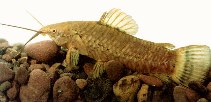| Family: |
Callichthyidae (Callichthyid armored catfishes), subfamily: Callichthyinae |
| Max. size: |
17 cm SL (male/unsexed); max.weight: 350.0 g |
| Environment: |
demersal; freshwater; pH range: 6 - 8; dH range: 5 - 19 |
| Distribution: |
South America: Amazon and Orinoco River basins, as well as coastal rivers of the Guianas and northern Brazil. |
| Diagnosis: |
|
| Biology: |
Ubiquitous (Ref. 35381). Occurs in ponds (Ref. 11229), swamps and flooded savanna. May also occur in inland creeks with strong current. When the swamps are drained during the dry season, they burrow in the mud at a depth of 15-25 cm and remain there until the first rains. They hide only at the bottom of the marshes which remain always a little muddy even during the dry season. Today, they are presently captured with the net. Previously, fishermen drained the marshes in order to unearth the fish which had hidden there (Ref. 27188). Omnivore (Ref. 26543). Intestinal breathing, complementary to branchial breathing, enables them to adapt to extreme hypoxic conditions which occur in their biotopes. For these reasons, the relevant intestinal zone has a more reduced mucus epithelium as well as an increased blood system. In the dry season when swamps get dry, they sink deeper into the muddy substrate down to a depth of 20 cm. This way, they live at a slower pace, often in groups, until the next rainy season. At the end of October, the fishermen dig them up because they are appreciated for their flesh. At other times, they are fished with nets (Ref. 35381). |
| IUCN Red List Status: |
Least Concern (LC); Date assessed: 20 October 2020 Ref. (130435)
|
| Threat to humans: |
harmless |
Source and more info: www.fishbase.org. For personal, classroom, and other internal use only. Not for publication.

